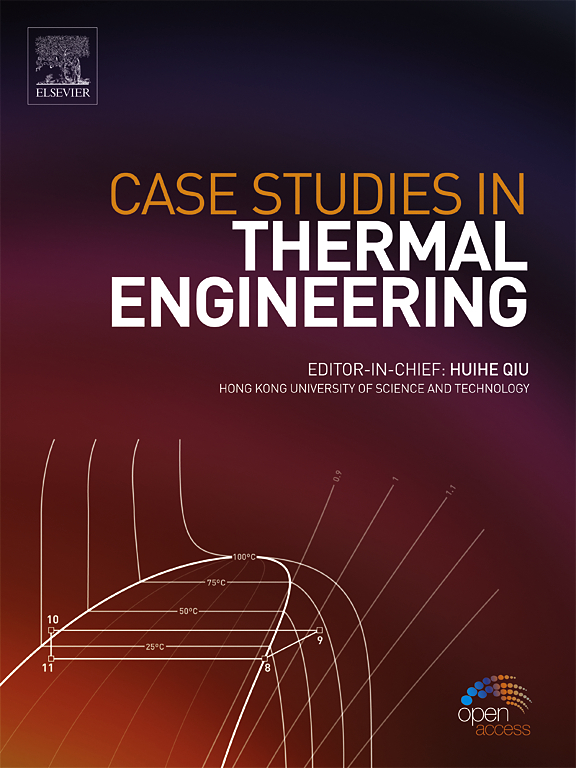利用达西-福赫海默-布林克曼模型模拟多孔介质中磁化 SWCNT-MWCNT 混合纳米流体的流动并进行非相似分析
IF 6.4
2区 工程技术
Q1 THERMODYNAMICS
引用次数: 0
摘要
多孔介质中的混合纳米流体传输领域在优化热加工和各种热力学应用方面前景广阔。本研究探讨了水与单壁和多壁碳纳米管(SWCNT-MWCNT)协同组合的混合纳米流体在穿越垂直拉伸的多孔表面时的流动动力学。这种流动情景的数学建模考虑了磁流体力学(MHD)、粘性耗散、热源和欧姆加热等影响因素。采用达西-福克海默-布林克曼模型来捕捉流体在多孔介质中的传输过程。通过应用局部非相似性(LNS)技术,将控制方程转换为无量纲系统,并使用 MATLAB 中的鲁棒 bvp4c 函数进行数值求解。有趣的是,热源参数值越高,温度曲线越呈上升趋势,这凸显了系统的热学和流体动力学之间错综复杂的相互作用。这项工作为定制设计混合纳米流体和多孔介质配置以利用其增强的热传输能力提供了宝贵的见解,有望应用于储能系统、热交换器和热管理设备等多个领域。这些发现有助于加深对多孔介质中混合纳米流体传输的理解,并为在广泛的工业和技术领域开发创新的热管理解决方案铺平了道路。本文章由计算机程序翻译,如有差异,请以英文原文为准。
Simulation and non-similar analysis of magnetized SWCNT-MWCNT hybrid nanofluid flow in porous media using Darcy–Forchheimer–Brinkman model
The field of hybrid nanofluid transport through porous media holds immense promise for optimizing thermal processing and various thermodynamic applications. This study investigates the flow dynamics of a hybrid nanofluid, comprising water and a synergistic combination of single-walled and multi-walled carbon nanotubes (SWCNT-MWCNT), as it traverses a vertically stretched porous surface. The mathematical modeling of this flow scenario considers the influential factors of magnetohydrodynamics (MHD), viscous dissipation, heat sources, and ohmic heating. The Darcy–Forchheimer–Brinkman model is employed to capture the transport of fluid through the porous medium. Through the application of Local Non-Similarity (LNS) technique, the governing equations are converted into a dimensionless system and solved numerically using the robust bvp4c function in MATLAB. Interestingly, higher values of heat source parameter leads to a rising trend in the temperature profile, highlighting the intricate interplay between the thermal and fluid dynamic aspects of the system. This work provides valuable insights into the tailored design of hybrid nanofluids and porous media configurations to harness their enhanced thermal transport capabilities, with potential applications in diverse fields such as energy storage systems, heat exchangers, and thermal management devices. The findings contribute to the broader understanding of hybrid nanofluid transport in porous media and pave the way for the development of innovative thermal management solutions in a wide range of industrial and technological domains.
求助全文
通过发布文献求助,成功后即可免费获取论文全文。
去求助
来源期刊

Case Studies in Thermal Engineering
Chemical Engineering-Fluid Flow and Transfer Processes
CiteScore
8.60
自引率
11.80%
发文量
812
审稿时长
76 days
期刊介绍:
Case Studies in Thermal Engineering provides a forum for the rapid publication of short, structured Case Studies in Thermal Engineering and related Short Communications. It provides an essential compendium of case studies for researchers and practitioners in the field of thermal engineering and others who are interested in aspects of thermal engineering cases that could affect other engineering processes. The journal not only publishes new and novel case studies, but also provides a forum for the publication of high quality descriptions of classic thermal engineering problems. The scope of the journal includes case studies of thermal engineering problems in components, devices and systems using existing experimental and numerical techniques in the areas of mechanical, aerospace, chemical, medical, thermal management for electronics, heat exchangers, regeneration, solar thermal energy, thermal storage, building energy conservation, and power generation. Case studies of thermal problems in other areas will also be considered.
 求助内容:
求助内容: 应助结果提醒方式:
应助结果提醒方式:


